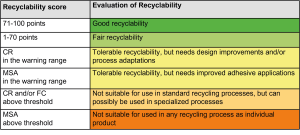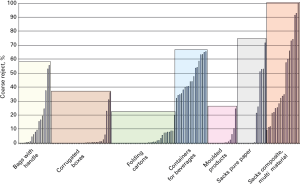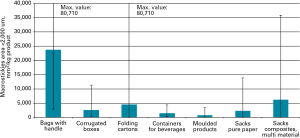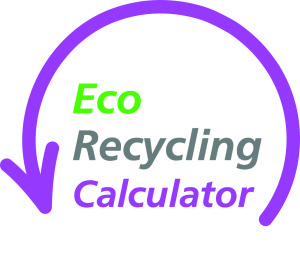The European project ended a year ago, after two years of work. The main results were presented and discussed at the conference held at Krakow in December 2014 and then finalised in documents and publications available to companies and stakeholders of the production chain.
The results obtained in more than two years of work on issues relating to the recycling of paper packaging, from the design and recyclability of products, to environmental sustainability, strategies for improving collection and the politics which regulate the production chain for the recycling of paper materials, and the many opportunities to meet and compare with companies and players of the sector, have enabled four guideline documents to be drawn up on the main aspects regarding the recycling of paper products, in particular packaging.
- Guidelines on the recyclability of paper-based products. The main aspects of the design and creation of products are related to the paper recycling process and the level of recyclability achievable. The main methods for assessing technical aspects of recyclability are grouped together in one section, including the latest recent updates of some methods.
- Guidelines on the eco-design of products and sustainability criteria of recycling. The document contains an assessment of how the level of recyclability of products and the results of some parameters of the recyclability tests can determine the environmental emissions of the recycling process itself. The relationship described between the recyclability of products and environmental emissions of the recycling process is the starting point for the assessment of the end of life scenario of paper-based products in the Life Cycle Assessment studies.
- Guidelines on strategies and systems for the collection of paper for recycling. The various factors and aspects which can influence local and regional strategies for the collection of paper are presented in relation to the manufacturing, economic, social and environmental factors of the area of interest. Other important factors are illustrated which affect the results of the collection, like the information published, education and incentive schemes, and some examples of successes are also given.
- Guidelines on the policies and strategies for improving recycling. The document contains some recommendations supporting regional and national regulations and policies in relation to aspects of recycling paper-based products, with the aim of identifying a common strategy, achieving agreed objectives and guaranteeing the availability and quality of paper for recycling.
The publication containing the four Guidelines and the presentations of the Krakow conference are available on the internet.
Other important results were obtained in the project. A description of the main tools and documents available follows.
Analysis of the recyclability of products
In accordance with the new method of analysis of the recyclability of paper-based packaging products, developed, validated and applied during the project, called EcoPaperLoop 1 Method, 168 packaging products were tested. These products were supplied by paper mills, companies which process and manufacture packaging (pre-consumer), end users (post-consumer).
The results were categorised and drawn up into a database shared between the European countries involved in the tests, with the intention of gradually developing it in the future so as to have an information resource on the state-of-the-art and evolution of the products used in the market.
The products were selected in five countries – Italy, Germany, Slovenia, Poland and Hungary – and classified into the following categories representing almost all types of existing products:
- Corrugated boxes, some of which had plastic lamination;
- Folding cartons, both for common products and for frozen ones, some of which had plastic lamination;
- Paper bags with handles, shopper type, of various forms and types;
- Sacks in pure paper;
- Sacks made of composite, multi-materials;
- Containers for beverages;
- Moulded cellulose products;
- Various other materials.
In order to interpret the results obtained in the laboratory tests, an assessment system was drawn up, able to express the overall level of recyclability of the product using a score and linked judgement, following the example of the assessment system already used for the recyclability of printed products.
The assessment scheme allows the level of recyclability of the product to be assessed using a score varying from 0 to 100 points, based on the result of the four main parameters of the test in accordance with the EcoPaperLoop Method 1, that is the content of Coarse reject and Flakes, Macro-stickies area less than 2,000 µm in diameter, level of Optical homogeneity (table 1).

The Threshold is defined for each parameter (the same for all the product categories) and also the Target value, depending on the product category.
If the result of a parameter does not meet the Threshold, the score is not calculated but the product is assigned a judgement in accordance with table 2, 3.


Vice versa, if the result is equal to or above the Target value, the maximum score available for that parameter is assigned.
Furthermore, for the Coarse reject and Macro stickies parameters, a Warning range is defined, that is a range of results for which the product is considered recyclable but with some recommendations for improving the result, as reported in table 4.

The results relating to the two main parameters are reported below, aggregated by product category.


The Scorecard assessment scheme is, at the moment, neither published nor adopted by international bodies, but is used for research in laboratories which have taken part in the project and for future development of the database of recyclability of paper packaging products.
The Scorecard assessment scheme and the database of results are at the moment available upon request.
Eco-design, sustainability and Life Cycle Assessment
On the basis of the study of the relationship between the results of the recyclability tests and environmental emissions from the recycling process, both regarding printed products and packaging products, the most important categories of impact for the assessment of the end of life phase of paper products have been identified in the context of the Life Cycle Assessment.
There is an on-line tool called Eco-recycling Calculator which is available for a simplified analysis of environmental emissions and the calculation of the carbon footprint of the recycling process, based on the results of the parameters obtained in the recycling tests or based on average values of the same parameters available for the different product categories.
Eco-recycling Calculator is publicly available here.
The methodology developed has therefore been applied and validated in two LCA studies, one regarding corrugated cardboard products and the other regarding printed products. The products, made using various manufacturing solutions, designs and finishes/packaging, have been analysed and compared using primary data supplied by two major companies involved in the study and using data extracted from validated databases and literature, when the primary data is not available.
Furthermore, two LCA screening studies have been carried out respectively on graphics products and packaging products, with the aim of assessing various recycling options and end of life scenarios:
- Printed paper products: comparison between two average daily newspapers printed with offset technology and standard flexographic printing. In particular, the scenarios of recycling material within the same graphics paper manufacturing cycle or the effect of recycling for the manufacture of lower grade products, for example for the manufacture of packaging paper, were assessed.
- Packaging products: comparison between different types of bags with a handle, shoppers just made from paper and shoppers with plastic lamination. In particular, the impact of three different scenarios for the end of life of products was assessed, that is recycling in standard plants, recycling in specialist plants and disposal by waste-to-energy methods.
Strategies for collecting and politics for recycling
The aspects of the main systems of collecting paper for recycling applied in the regions and countries of central Europe have been analysed. The physical, economic, infrastructural, social factors, and all other factors which have an effect on the choice and success of the various collection systems, were analysed. The correlation between the drivers and the results of the collection were identified, and the study then went into greater depth with the information collected, thanks to a large number of interviews and meeting with companies in the sector, public administration and players involved in the collection.
The data obtained was used to develop an on-line tool to analyse and help make a choice regarding the use and/or development of local collection systems. The tool is an on-line, multiple-choice questionnaire developed in the form of a decision-tree, available publicly here.
Concurrently, information and data was collected regarding programmatic strategies and policies regarding the paper recycling chain, using interviews, meetings and investigations conducted with public administrations, local bodies and various entities responsible for decisional and organisational processes.
The analysis of the current situation of regulations, laws and provisions applied, linked with the information collected, has enabled the development of some recommendations for the implementation and development of a general framework of regulations and harmonised policies for the regions and countries of the area studied, with the aim of encouraging the collection, availability and quality of paper for recycling.
The recommendations can form a basis also for the entire EU area and are developed in line with the framework of objectives and European policies for the next few years, from the point of view of the use of resources, environmental sustainability and circular economy, as well as taking into account the possible future economic and social scenario.
The reference document, Road Map Report: Policy Guidelines, is at the moment available upon request.
References and further information
For a full consultation of the guideline documents and the testing methods, please go to the website, where most of the documents are available in both English and Italian.
Some reports and documents mentioned are, at the moment, in the final stage of approval by the European Commission, and therefore are available on request from Innovhub – Paper division.

